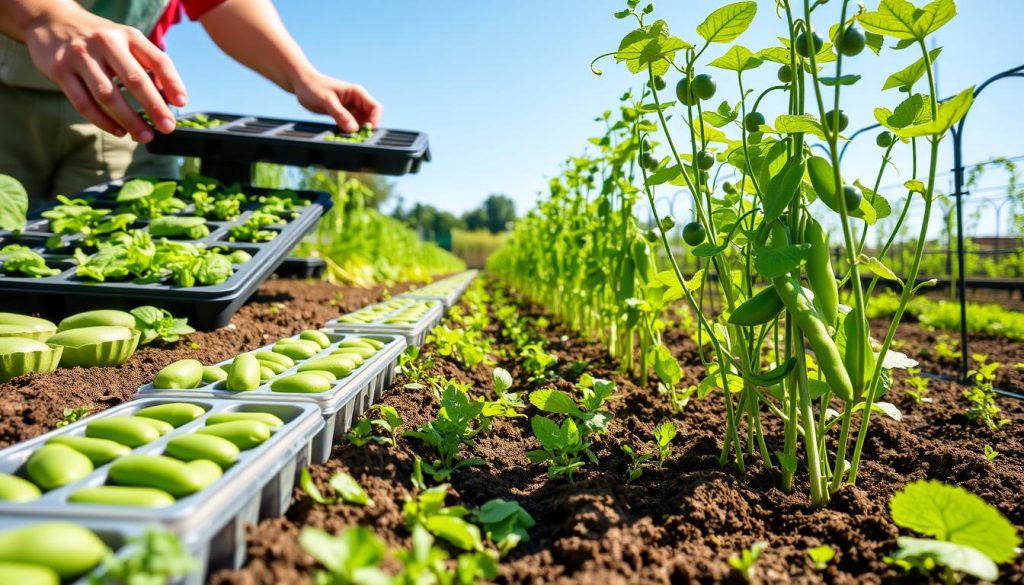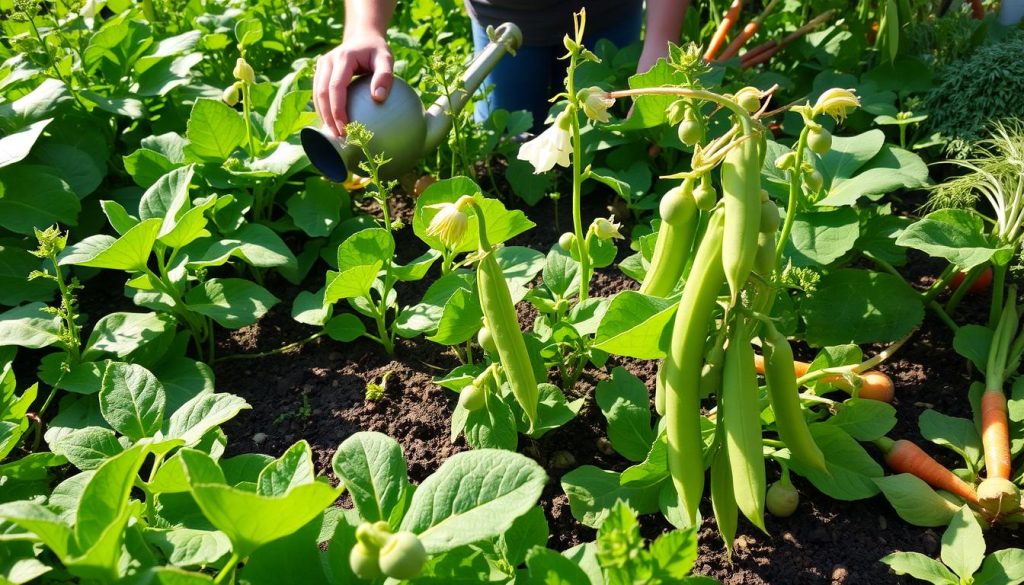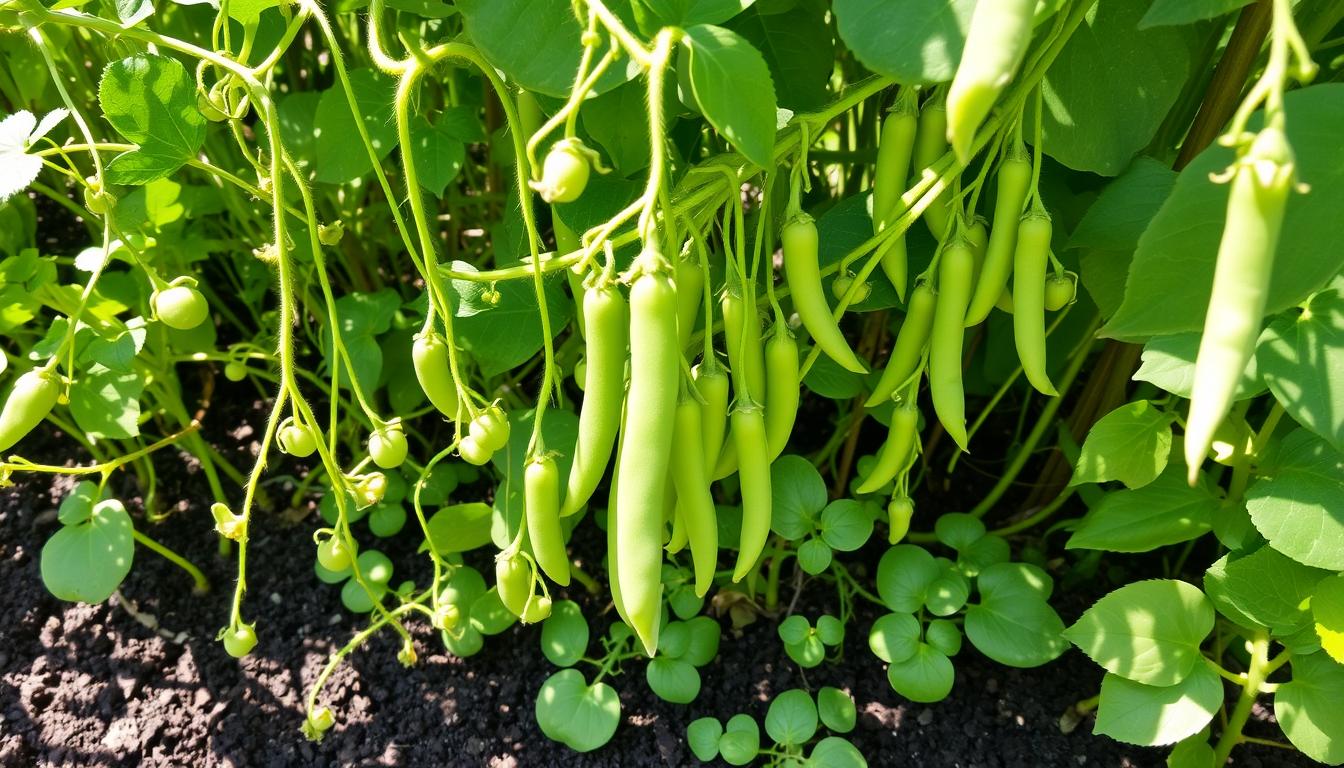Welcome to your comprehensive vegetable similar to pea guide! If you love gardening, learning about peas and other legumes can make your gardening better. Peas are tasty, grow well vertically, and help the soil by fixing nitrogen. In this guide, you’ll find out about different pea types and get gardening tips to make your garden great.
As you learn more about planting peas, you’ll find other vegetables that go well with them. You’ll learn about climbing crops like pole beans and cucumbers. You’ll also get tips on how to plant for better growth and efficiency. This guide will help you grow a successful garden and enjoy what you grow!
Understanding the Basics of Peas and Their Varieties
Peas are loved by gardeners for their sweet taste and versatility. You can grow snap peas, snow peas, and sweet peas. Knowing about each type makes gardening better and helps your peas grow well. Trellising peas is key for healthy plants and more harvest.
Types of Peas: Snap, Snow, and Sweet
It’s important to know the different peas. Here’s a quick look:
- Snap Peas: These have tasty pods and are ready in under 60 days. Sugar Ann is ready in 55 days, and Sugar Snap takes about 66 days.
- Snow Peas: They have flat, edible pods and are great in stir-fries. Oregon Sugar Pod is ready in 70 days and fights off diseases well.
- Sweet Peas (Shelling Peas): You need to shell them to eat the peas inside. Little Marvel grows small plants with sweet peas in 65 days.
Growing Conditions for Peas
Peas need the right conditions to grow well. They love cool weather, between 60°F and 70°F. They also need well-drained, loamy soil with a pH of 6.0 to 7.0. Different peas mature at different times, like:
| Pea Variety | Maturity Time (Days) | Peas per Pod |
|---|---|---|
| Tall Telephone | 60 | Varies |
| Little Marvel | 65 | 7-8 |
| Wando | 70 | 7-8 |
| Misty Shell | 60 | 7-8 |
| Oregon Sugar Pod | 70 | Varies |
| Little Snowpea White | 30 | Varies |
Importance of Trellising Peas
Trellising peas is crucial for their growth. Since they climb, a strong support helps them grow upright. This method saves space and improves air flow, reducing disease risks. Trellises lead to healthier plants and more peas, showing the value of good trellising.
Exploring Vegetables Similar to Peas
When you grow vegetables like peas, knowing who they get along with is key. Pole beans and cucumbers are great friends for peas. They save space and add new tastes and health benefits.
Pole Beans: A Climbing Companion
Pole beans are perfect for vertical gardening. They climb up, making a beautiful green wall with peas. Using A-frames or tepees helps them grow up, saving space.
This way, they get more air and sunlight. This makes them healthier and stronger.
Cucumbers: Another Vertical Grower
Cucumbers climb like peas, making them great for vertical gardens. They use their tendrils to climb up, growing tall and fruiting well. Growing them with peas makes your garden lively and diverse.
What Makes a Vegetable Similar to Peas
Vegetables like peas climb, grow well, and are full of nutrients. They need support and like the same weather. They’re also packed with vitamins and minerals, making them good for you.
Knowing these things helps you pick the best plants for your garden. This way, you get a healthy and tasty harvest.
Vegetable Similar to Pea Guide for Gardeners
When planning your garden, picking the right veggies to go with peas is key. Think about how much space they need and if they grow well together. Choosing wisely not only boosts your garden’s yield but also makes it look good.
Choosing the Right Vegetables for Your Garden
Choosing veggies that grow well with peas can make your garden thrive. Here are some important things to consider:
- Compatibility: Pick veggies that need similar things to grow, like the same amount of water and sunlight.
- Succession Planting: Plant at different times to keep your garden busy all season. This way, you’ll always have something to harvest.
- Row Spacing: Make sure rows are far enough apart for air and sunlight. This helps your plants grow strong and healthy.
Planting Techniques for Pea-Like Vegetables
Good planting methods are crucial for pea-like veggies to grow well. Here are some tips:
- Soil Preparation: Make sure the soil’s pH is between 5.8 and 7.0. Add organic stuff to make it richer.
- Proper Depth: Plant seeds 1 to 2 inches deep, and space them 1½ to 3 inches apart in the row.
- Timing: Check the weather and planting times in your area. Plant seeds every two to four weeks for a steady harvest.
Using the right planting methods can really boost your garden’s yield. With the right approach, you can grow a variety of pea-like veggies that do great with your peas.

| Vegetable | Acreage | Dollar Value per Acre | Total Value |
|---|---|---|---|
| Dry Beans | 50,500 | $325 | $16,400,000 |
| Southern Peas | 19,000 | $400 | $7,600,000 |
| Green/Snap Beans | 10,900 | $1,100 | $11,990,000 |
| Guar Crop | 40,000 | $125 | $5,000,000 |
| Lima Beans | 700 | $1,200 | $840,000 |
| Mung Beans | 100 | $225 | $23,000 |
| English Peas | 100 | $600 | $60,000 |
| Other Beans | 300 | $170 | $51,000 |
Caring for Pea Varieties and Their Friends
Proper care for peas and similar vegetables is key for healthy plants and plenty of harvests. This guide will cover important topics like watering, pest management, and harvesting.
Watering and Nutrient Needs
Understanding the watering needs of peas is crucial for their growth. Water your pea plants regularly, keeping the soil moist but not too wet. Watering in the morning helps the plants soak up moisture all day.
Adding 1 to 2 inches of compost to the soil provides the necessary nutrients. Peas need phosphorus and potassium, not just nitrogen, for strong growth. Mulching with straw or grass clippings helps keep the soil moist and controls weeds.
Pest Management and Disease Prevention
Managing pests is vital for pea care and preventing losses. Watch out for aphids and cutworms. Catching these pests early is important for effective control.
For organic pest control, use insecticidal soaps or neem oil. Choose resistant varieties to fight diseases like the Pea Enation Mosaic virus. Crop rotation and planting resistant types like ‘Oregon Sugar Pod II’ or ‘Sugar Ann’ also help prevent diseases.
Harvesting Techniques for Optimal Yield
Harvesting peas at the right time is essential for their flavor. Check the pods often; sugar snap and snow peas are ready when plump but still tender. Harvesting at the right time ensures better taste, as peas keep their flavor for about a week in the fridge.
To harvest, use scissors or garden shears to avoid harming the plant. Follow these steps for the best yield and flavor of both peas and their climbing friends.

Conclusion
You’ve learned how great peas and pea-like veggies are for your garden. They help other plants grow well and make the soil better. Growing peas adds nutrition to your meals and helps the planet.
This guide showed you how to plant, care for, and pick your peas and their friends. Peas are full of fiber and vitamins, making them good for you and the earth. They’re better for the environment than meat, which is great for our planet.
Starting a garden is fun, and peas are a great place to begin. Try growing different veggies to make your meals more exciting. A diverse garden is not only tasty but also a fun adventure.
Source Links
- https://journeywithjill.net/gardening/2017/02/07/plants-that-climb-sprawl-choose-the-best-trellis-option-for-your-garden-big-or-small/
- https://www.cappersfarmer.com/yard-and-garden/vegetables-fruit-and-herbs/a-guide-to-vegetable-legumes-ze0z1608zsel/
- https://www.epicgardening.com/pea-types/
- https://sowtrueseed.com/blogs/gardening/types-of-peas?srsltid=AfmBOorDrFWIm-5W0Zuhk7z9Wx0cB2z679kW5pxSNm8OkZrK3XEqXzWV
- https://thestonesoup.com/blog/2020/01/17/vegetable-substitutes/
- https://www.foodandhealth.com/blog-free/myplate-starchy-vegetables
- https://alliancebioversityciat.org/stories/how-many-types-vegetables-are-there-complete-guide
- https://aggie-horticulture.tamu.edu/vegetable/guides/the-crops-of-texas/beans-and-vegetables-legumes/
- https://extension.psu.edu/a-gardeners-guide-to-peas
- https://www.swansonsnursery.com/blog/how-to-grow-peas
- https://www.bigblogofgardening.com/how-to-grow-peas-growing-tips-harvesting-planting-and-pests/
- https://pmc.ncbi.nlm.nih.gov/articles/PMC5073301/
- https://casadesante.com/blogs/wellness/substitute-for-peas?srsltid=AfmBOopdu8J6PR-ZEA4kbsY5fLxJmlDsiB5XJBL-iqQL7haOITNi7qWm
- https://www.cleaneatingkitchen.com/substitutes-for-green-peas/
